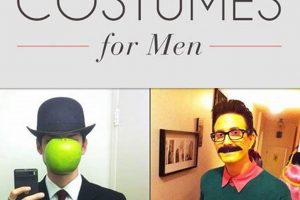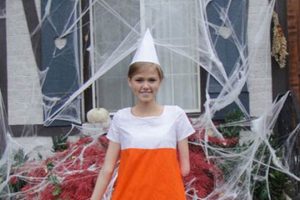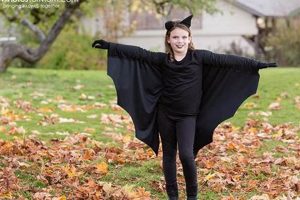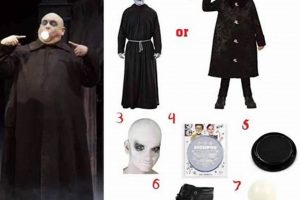Creating attire reminiscent of the infamous duo allows individuals to embody a specific historical aesthetic. This pursuit often involves assembling clothing and accessories to evoke the 1930s era, characterized by specific silhouettes, patterns, and color palettes. For example, a pinstripe suit paired with a fedora can suggest the male figure, while a knee-length skirt and beret may represent the female.
The appeal lies in its capacity for individual expression and resourceful repurposing of existing garments or economical crafting techniques. The accessibility of recreating iconic looks without substantial financial investment holds significant merit. Furthermore, participating in this activity provides a tangible connection to a notable period in history, albeit a controversial one, allowing for exploration of societal and cultural contexts.
The following sections will elaborate on the specific components required for constructing these themed outfits, offering guidance on sourcing appropriate materials and detailing relevant crafting techniques to achieve a credible visual representation.
Crafting Authentic Attire
Achieving a convincing portrayal of the iconic figures necessitates meticulous attention to detail. The following guidelines offer insights into creating representative ensembles through resourceful methods and informed selection of components.
Tip 1: Prioritize Research: Thoroughly examine visual references of the era, specifically photographs of the individuals in question. Note the common garments, accessories, and overall style prevalent during the 1930s.
Tip 2: Source Authentic Fabrics: When possible, opt for materials characteristic of the period. Wool, tweed, and cotton were commonly used for clothing. Consider vintage or reproduction fabrics to enhance authenticity.
Tip 3: Focus on Silhouettes: The shapes of the garments are crucial. For the male counterpart, a wide-legged, high-waisted trouser is vital. For the female, a knee-length skirt or dress with a slightly dropped waistline is recommended.
Tip 4: Accessorize Appropriately: Accessories are critical for completing the look. A fedora hat, suspenders, and a pocket watch are essential for the male figure. A beret, gloves, and a string of pearls are appropriate for the female.
Tip 5: Distress and Weather: To emulate the wear and tear of a life on the run, consider subtly distressing the garments. Techniques such as lightly sanding fabric or adding small, realistic stains can enhance the costume’s realism.
Tip 6: Consider Color Palettes: Muted colors were common during the 1930s. Browns, grays, and muted greens are appropriate choices. Avoid bright, contemporary colors that will detract from the historical accuracy.
Tip 7: Pay Attention to Hair and Makeup: Hairstyle plays a crucial role. Short, waved hairstyles were popular for women, while slicked-back hair was common for men. Makeup should be minimal and natural-looking.
By focusing on these key elements, a convincing visual representation can be achieved, allowing for a respectful and informed engagement with a specific era and its associated style.
The subsequent sections will delve into specific resources and techniques to further enhance the authenticity of the assembled attire.
1. Era-Appropriate Fabrics
The success of a “bonnie and clyde diy costume” hinges significantly on the selection of era-appropriate fabrics. This is because textiles are a primary visual cue that situates the attire within a specific historical context. The use of anachronistic materials instantly detracts from the authenticity, undermining the effort to replicate the iconic look. The effect of inappropriate fabric choice is immediate and detrimental to the overall impression. For instance, constructing a 1930s-style suit from modern, synthetic stretch fabric will appear demonstrably out of place, regardless of the cut or design. The inherent properties of the fabricits drape, texture, and sheenare intrinsically linked to the period in question.
Furthermore, the choice of fabrics influences not only the visual aspect but also the tactile and practical elements of the costume. Fabrics such as wool, tweed, and cotton, commonly used during the 1930s, possess distinct qualities in terms of weight, breathability, and durability. These characteristics impacted the way garments were worn and maintained. For example, a wool suit would have offered a certain level of insulation and structure, while a cotton dress would have been lighter and more adaptable to warmer climates. Understanding these properties allows for a more informed selection, resulting in a costume that not only looks accurate but also feels authentic. A practical example includes opting for a heavier weight cotton canvas for a work shirt, mirroring the durability sought in workwear of the period, as opposed to a thinner, more modern cotton blend.
In conclusion, the selection of era-appropriate fabrics is not merely an aesthetic consideration but a fundamental requirement for creating a credible and evocative “bonnie and clyde diy costume.” While challenges may arise in sourcing authentic materials, particularly those that are no longer readily available, the effort to identify and utilize historically accurate fabrics will contribute significantly to the overall success and impact of the costume. The connection between fabric and historical accuracy is undeniable, and ignoring this connection results in a diluted and less effective representation.
2. Silhouette Accuracy
Achieving silhouette accuracy is paramount in recreating attire inspired by the figures. The distinct shapes of clothing from the 1930s directly influence the visual impact and historical credibility of a “bonnie and clyde diy costume.” The precise outline and form of garments are immediately recognizable indicators of the era, making faithful replication critical. Deviation from these shapes diminishes the intended aesthetic.
- Men’s Suiting Proportions
The quintessential male silhouette of the period involved a high-waisted trouser, often wider in the leg, paired with a structured jacket featuring padded shoulders. The waistline placement elongates the legs, and the shoulder padding creates a V-shaped torso. Failure to incorporate these features results in a modern silhouette that lacks the characteristic shape of 1930s menswear. Current trends often favor lower waistlines and slimmer-fitting garments, rendering them unsuitable for this particular historical recreation.
- Women’s Dress and Skirt Lengths
For female representation, knee-length skirts and dresses were prevalent. The waistline was often subtly dropped, or defined at the natural waist, depending on the specific year and style. Hemlines significa
ntly shorter or longer than the knee deviate substantially from the period’s aesthetic, creating an anachronistic visual cue. Modern midi or maxi lengths, or mini skirts, immediately negate the intended historical impression. - The Influence of Undergarments
The shape of undergarments significantly impacted the outer silhouette. Corsets and slips were worn to create a smooth, defined shape under clothing. Recreating the absence of these garments, or using modern alternatives like shapewear, alters the intended drape and flow of the outer garments. Attention to these foundational elements is crucial for maintaining silhouette authenticity.
- Jacket and Coat Structures
Outerwear, such as jackets and coats, also contributed to the overall silhouette. These garments often featured tailored lines, structured shoulders, and specific lapel shapes. Modern jackets may lack the same level of structure or incorporate different design elements that clash with the 1930s aesthetic. Replicating the tailored lines and specific design features of period-appropriate outerwear is essential for a convincing portrayal.
The cumulative effect of these silhouette elements dramatically influences the overall success of a “bonnie and clyde diy costume”. While sourcing authentic fabrics and accessories contributes to the aesthetic, accurate silhouettes are fundamental in establishing the historical context. These proportions, from both clothing and supportive undergarments are a primary visual communicator. A commitment to these nuances ensures the costume achieves its intended purpose.
3. Accessory Sourcing
The acquisition of appropriate accessories constitutes a critical phase in the development of attire styled after the infamous duo. These supplementary items, while often small in scale, serve as potent visual signifiers, effectively situating the ensemble within the intended historical context. Therefore, meticulous attention to detail in accessory selection is paramount.
- The Significance of Headwear
Hats were ubiquitous during the 1930s, functioning as both practical necessities and stylistic markers. For a male portrayal, a fedora is almost indispensable. The specific style, crown height, and brim width should ideally align with examples from the period. For a female interpretation, a beret or a close-fitting cloche hat would be appropriate choices. Modern hat styles, even those with superficial similarities, often incorporate design elements that betray their contemporary origins. The presence of anachronistic headwear significantly detracts from the overall authenticity.
- Footwear Considerations
Footwear choices require careful consideration. Oxfords or dress boots for men and pumps or lace-up shoes for women were commonly worn. Modern sneakers or overtly contemporary shoe designs are unsuitable and undermine the historical accuracy. Restricting footwear to styles demonstrably prevalent during the 1930s reinforces the intended visual narrative. The condition of the footwear is also important. Shoes that appear excessively new or pristine may require subtle distressing to align with the character’s likely circumstances.
- The Role of Jewelry and Personal Effects
Jewelry and personal effects contribute subtle yet significant layers of detail. A pocket watch, suspenders, and tie clips are suitable for a male interpretation, while a string of pearls, gloves, and a small handbag are appropriate for a female persona. These items reinforce the character’s social standing and lifestyle. Modern jewelry designs or accessories with prominent logos should be avoided. The scale and style of these items should be understated and congruent with the period.
- Weaponry (Handle with Discretion)
While often associated with the figures, the inclusion of replica firearms requires extreme caution and adherence to all applicable laws and regulations. If opting to incorporate replica weapons, selecting models demonstrably used by the individuals and handling them responsibly is crucial. Improper or illegal use of replica firearms can have severe consequences, and ethical considerations should always supersede historical accuracy in this context.
The careful selection and integration of historically appropriate accessories elevates the overall effectiveness of a “bonnie and clyde diy costume,” transforming it from a generic costume into a more nuanced and historically grounded portrayal. The strategic use of these elements serves as a powerful tool for conveying the intended aesthetic and narrative. However, when in doubt, it is best to omit accessories rather than risk including inaccurate or inappropriate items. The addition of weapons must always be handle with care and attention. Safety and ethical considerations always supercede everything.
4. Distressing Techniques
The application of distressing techniques is integral to achieving an authentic representation within a “bonnie and clyde diy costume.” These techniques simulate the effects of wear and tear, implying hardship and a life removed from conventional comfort, circumstances readily associated with the historical figures. The absence of distressing creates a dissonance, presenting an attire inconsistent with the narratives surrounding the individuals.
Distressing techniques can manifest in several forms, each contributing to the overall effect. These include, but are not limited to: subtle abrasion of fabric edges to simulate fraying, the strategic application of diluted dye or paint to create the appearance of staining or discoloration, and the introduction of minor tears or repairs to suggest prolonged use. The intentional introduction of imperfections through these methods transforms pristine garments into plausible representations of clothing subjected to challenging conditions. For instance, lightly sanding the brim of a fedora or applying diluted brown dye to a shirt collar can effectively simulate wear and age. The omission of these details results in a costume that lacks the depth and realism required for a convincing portrayal.
Effective utilization of distressing techniques necessitates a degree of restraint and an understanding of historical context. Over-distressing can appear artificial or cartoonish, diminishing the desired effect. The goal is to create subtle visual cues that suggest age and wear without overwhelming the garment. Careful examination of photographs and historical accounts can provide valuable insights into the types of wear and tear that would be appropriate for a specific “bonnie and clyde diy costume.” Therefore, the application of distressing techniques functions as a nuanced art, requiring both technical skill and historical awareness to achieve the desired level of authenticity.
5. Color Palette Restraint
The selection of colors constitutes a pivotal aspect of crafting a convincing attire inspired by figures. A restricted palette, characteristic of the 1930s, profoundly influences the perceived authenticity of the result. The deliberate avoidance of vibrant, contemporary hues is not
merely a stylistic preference but an essential component in conveying the intended historical context. The presence of anachronistic colors immediately disrupts the illusion, signaling a departure from the period. This constraint acts as a critical filter, ensuring that the final outcome aligns with the visual cues associated with that era. For example, the predominance of muted browns, grays, and greens in garments recreates the visual aesthetic commonly found in historical photographs and films depicting the 1930s, thereby solidifying the costume’s association with the intended time frame.
Further consideration extends to the specific shades and tones within this restricted spectrum. The saturated, jewel-toned colors often found in modern textiles were uncommon in the mass-produced clothing of the 1930s. Instead, dyed fabrics often exhibited a more subdued and weathered quality. Replicating this faded appearance can be achieved through careful selection of fabrics or through the application of distressing techniques. The specific dye processes and availability of pigments during that era significantly influenced the range of colors. For example, achieving a vibrant, electric blue would be historically inaccurate, whereas a muted, slightly desaturated blue-gray would be a far more appropriate choice. This understanding extends to the accessories, where items like hats, gloves, and jewelry should also adhere to the same restrained color palette, ensuring consistency throughout the ensemble.
In summary, color palette restraint represents a fundamental principle in the pursuit of an accurate and evocative representation of figures. By adhering to the limited range of colors prevalent during the 1930s and carefully considering the specific shades and tones within that range, the overall credibility of the costume can be significantly enhanced. Ignoring this constraint compromises the historical illusion, regardless of the accuracy of other elements. The disciplined application of this principle serves as a cornerstone in achieving the desired visual effect, grounding the recreation within its intended historical context.
6. Hair/Makeup Resemblance
Achieving visual accuracy in a recreation significantly depends on hairstyle and makeup. These details contribute to the overall credibility of the portrayal, directly influencing the resemblance to the historical figures.
- Hairstyle Authenticity
The hairstyles prevalent in the 1930s differ substantially from modern trends. For a female portrayal, replicating short, waved styles is crucial. Specific techniques, such as finger waving or pin curling, were commonly employed to achieve these looks. For a male portrayal, slicked-back hair or neatly styled short cuts were typical. Modern hairstyles, regardless of clothing accuracy, diminish the overall historical impression. Precision in replicating these styles is paramount for visual authenticity.
- Makeup Minimalism
Makeup during the 1930s favored a natural appearance, in sharp contrast to contemporary trends that often emphasize bold colors and dramatic techniques. The application of foundation aimed for a smooth, even complexion, while blush was used sparingly to add a touch of color to the cheeks. Eyeshadows were generally muted and natural-looking, and lipstick shades leaned towards deeper reds or burgundies. Overuse of modern makeup techniques, such as contouring or highlighting, detracts from the historical accuracy. Maintaining a subtle and understated makeup application is essential.
- Eyebrow Shaping
Eyebrow shape was a defining characteristic of the 1930s aesthetic. Thin, arched eyebrows were fashionable, often achieved through plucking or shaping. Modern eyebrow trends, which favor thicker, more natural shapes, clash with the intended historical portrayal. Replicating the thin, arched eyebrow shape of the period contributes significantly to the overall resemblance.
- Skin Tone and Complexion
While not always modifiable, skin tone and complexion contribute to the overall impression. A pale complexion was often considered desirable during the 1930s. Excessive tanning or the use of bronzer detracts from the historical accuracy. Maintaining a natural skin tone or, if desired, lightening the complexion slightly, aligns more closely with the period’s aesthetic.
Attention to these subtle yet crucial details in hairstyle and makeup enhances the overall visual impact of the inspired creation. The precision of hairstyle along with the subtlety and attention on complexion, and shape of the eyebrows are subtle details that, while easy to overlook, have a substantial effect. Fidelity to these practices is key to obtaining a convincing portrayal, thereby increasing the perceived authenticity.
Frequently Asked Questions
The following addresses common inquiries and misconceptions surrounding the creation of attire inspired by the aforementioned figures, providing clear and informative responses.
Question 1: Is complete historical accuracy essential for an effective representation?
Complete adherence to historical accuracy is not always mandatory, achieving a convincing portrayal necessitates attention to key elements, namely silhouette, color palette, and prominent accessories. Selective approximation may suffice.
Question 2: Where can era-appropriate fabrics be sourced economically?
Thrift stores, vintage clothing shops, and online marketplaces often provide affordable options for sourcing suitable fabrics. Repurposing existing garments represents another cost-effective strategy.
Question 3: Are specific patterns required for replicating 1930s clothing styles?
While authentic patterns enhance precision, adapting modern patterns with alterations to neckline, sleeve style, and garment length can achieve a reasonably accurate silhouette.
Question 4: How can garments be distressed effectively without damaging them irreparably?
Subtle distressing techniques, such as lightly sanding edges or applying diluted dye, minimize potential damage. Practicing on scrap fabric before applying techniques to the final garment is advisable.
Question 5: Is the inclusion of replica firearms necessary for a compelling portrayal?
The inclusion of replica firearms is not essential and poses potential safety and legal concerns. The costume’s effectiveness relies on accurate clothing and accessories, rather than potentially hazardous props.
Question 6: How can appropriate hairstyles be achieved without professional assistance?
Numerous online tutorials provide guidance on replicating 1930s hairstyles using basic styling techniques. Practicing these techniques prior to the event is recommended.
In summary, creating a persuasive attire requires careful consideration of key historical elements, resourceful sourcing of materials, and responsible application of techniques. Ethical and safety considerations should always override any desire for absolute historical accuracy.
The next section will address strategies for assembling this attire for various body types, offering solutions for ensuring a flattering and authentic representation.
Conclusion
The preceding exploration has detailed core aspects essential to creating convincing attire inspired by the figures. Emphasis has been placed on era-appropriate fabrics, silhouette accuracy, accessory sourcing, distressing techn
iques, color palette adherence, and hair/makeup resemblance. Diligence in these areas significantly impacts the overall visual effectiveness of such recreations.
The successful execution of attire inspired by these figures involves a commitment to research, resourceful material acquisition, and ethical judgment, especially regarding potentially sensitive elements like replica weaponry. Individuals undertaking this project are encouraged to prioritize historical context and artistic interpretation over literal replication, promoting a respectful and informed engagement with history.







